|
 Gliophorus subheteromorphus Gliophorus subheteromorphus
SynonymsHygrocybe subheteromorpha
BiostatusPresent in region - Indigenous. Non endemic
Images (click to enlarge)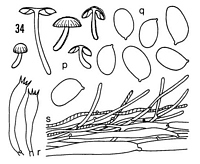
Caption: Gliophorus subheteromorphus (Singer): u. carpophores. - q. spores. - r. basidia. - s. cuticle (Herb. HK. ZT 68/526) | 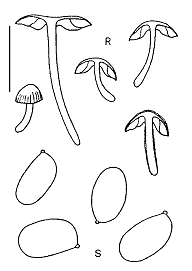
Caption: Fig. 35 Gliophorus subheteromorphus (Sing.) Horak (R-S: ZT 68/526):
R. basidiomes. S. spores. | 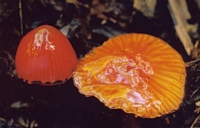
Caption: Gliophorus subheteromorphus
Owner: Kaimai Bush | 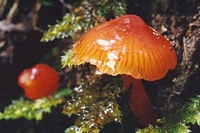
Caption: Gliophorus subheteromorphus
Owner: Kaimai Bush | 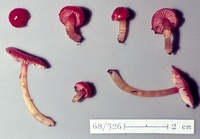
Caption: ZT68-526
Owner: E. Horak: © Creative Commons Attribution-Noncommercial 3.0 New Zealand | 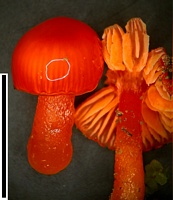
Caption: scale=1cm
Owner: J.A. Cooper | 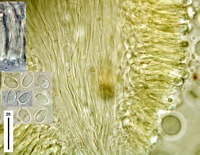
Caption: basidia, spores and trama.
Owner: J.A. Cooper |
Article: Horak, E. (1990). Monograph of the New Zealand Hygrophoraceae (Agaricales). New Zealand Journal of Botany 28(3): 255-306 (http://www.rsnz.org/publish/abstracts.php).
Description:
Pileus -20 mm, hemispherical, convex becoming expanded with depressed centre;
scarlet to tomato red; glutinous, conspicuously striate at margin, glabrous.
-Lamellae 12-16 (1-3) adnexed to adnate, white with reddish tinge, turning reddish
orange with age, edges entire, concolorous, without glutinous thread. - Stipe
10-35 x 1-2 mm, cylindrical, equal; concolorous with pileus or orange with
reddish tinge; glutinous, gabrous, fistulose, single. - Context red orange,
yellowish towards base of stipe. - Odour and taste not distinctive. - Chemical
reactions on pileus: KOH - yellow.
Spores 8-10.5 x 5-7 um, ovoid. - Basidia 32- 35 x 7-10 um, 4-spored. - Cystidia
absent - Pileipellis an ixocutis of repent to interwoven, cylindrical hyphae
(4-10 um diam.), membranes gelatinised, with encrusting and/or plasmatic pigment;
clamp connections present (Pl. 1, Fig. 6).
Habitat: ECOLOGY: Scattered; saprobic on soil in broadleaved forest or occasionally
on rotten wood of Dacrydium cupressinum. April-May.
Distribution: DISTRIBUTI0N: NZ, N), South America (Chile).
Article: Horak, E. (1973). Fungi Agaricini Novazelandiae I-V. Beihefte zur Nova Hedwigia 43: 200 p.
Description: Pileus 5-20 mm diam., hemispherical, convex or becoming flat with depressed centre, scarlet or tomato red, glutinous, conspicuously striated, glabrous. Lamellae adnexed to adnate, whitish-reddish when young becoming reddish-orange, ventricose, gill edge concolorous. Stipe 10-35 x 1-2 mm, cylindric, equal, concolorous with pileus or reddish-orange, glutinous, glabrous, fistulose, single. Context red-orange, yellowish towards the base of the stipe. Taste and odor not distinctive. Chemical reactions on pileus: KOH - yellow.
Spores 8-10.5 x 5-7 µm, ovoid, smooth, inamyloid. Basidia 32-35 x 7-10 µm, 4-spored. Cystidia absent. Cuticle an ixocutis composed of repent or suberect cylindric, strongly gelatinized hyphae (4-10 µm diam.), plasmatic and encrusting pigment present. Clamp connections on the septae.
Habitat: On soil or on rotten bark under Dacrydium cupressinum. New Zealand; South America (Chile).
Notes: Since we have not studied the type of G. subheteromorpha Singer we refer our N.Z. material with some hesitation to this taxon. But there is a striking coincidence of the macroscopic and microscopic characters as well so it may likely be that the area of distribution stretches from Chile to New Zealand. Furthermore the N.Z. fungus is also closely related to H. araucana Singer, another species described from Chilean forests.
|